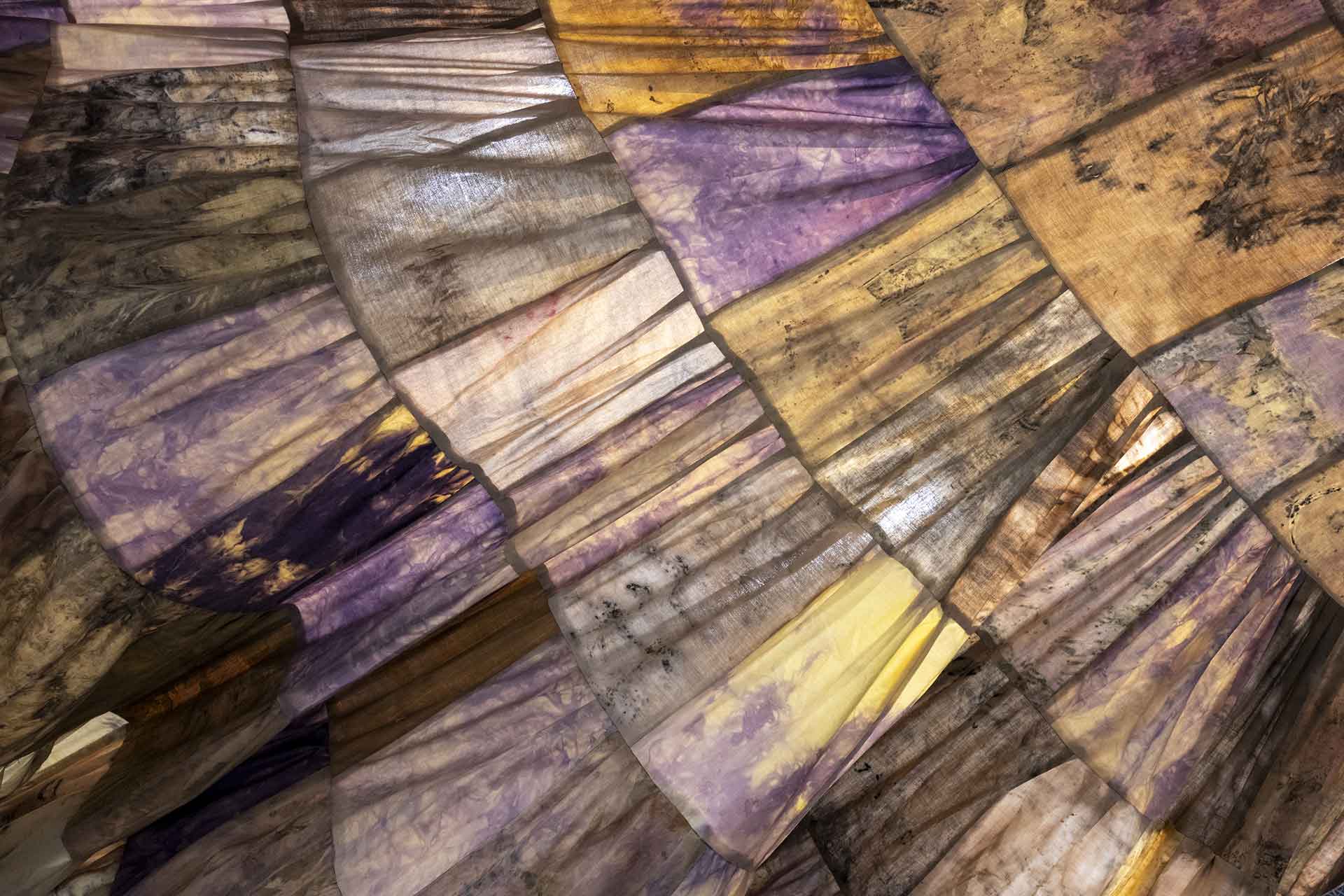Projects / Worlding
Hyperbolic Duvet
A ruffled duvet assembled from eco-printed rectangles, eventually to total 756, in creation alongside Slow Social Club. I create the fabric by sewing together individually dyed and printed rectangles using a pattern inspired by hyperbolic crochet: 1+ increase. In crochet, this would mean ‘make one stitch, then stitch twice into the next stitch’. When I use this pattern to create fabric it creates deep ruffles that flair from the waist like the train of an evening gown.
In the first days of a salmon run, before anyone knows for sure where they are, at high tide in the early evening we’re scanning the rocks by the shadow of the bridge at Lower Road: the sight of a spine breaking the water reads as part of the creek’s fabric. We imagine where we’ll see the next one. Piecing glimpses of fins into guesses, feeling the eagerness in the water like the shiver of cloth pulled quickly off the roll –– all of us pulled upstream and into the trees by the continuity of that need.
The narrowest section of fabric was dyed and printed to respond to sunset colours reflected in the ocean at the end of Roberts Creek pier, facing towards ts'uḵw'um/Wilson Creek. As the fabric widens and ruffles, the colours follow the water upstream through the mouth of the creek and into the forest, taking the Emery Road trail to the culvert that runs under the highway, crossing a bridge to the creek’s opposite shoulder and walking it back downstream to where it meets Clack Creek. This is a trail my partner and I take often with our dog, Wendy.
Once in the forest, the water is olive green, rust, tan and burgundy depending on its depth and flow over rocks and whether you’re watching from an earthy, ferned or stony flank of the ravine. Where the water deepens and slows it reflects the forest which is extravagantly green, draped in lichen, mossed everywhere, and surprisingly intact. When it’s running fast, the tea brown of mountain runoff is nearly overcome by foam.
This past fall, we walked the trail to watch the salmon spawn, fretting as they humped themselves over exposed rocks in low water. Weeks later, we cringed when the rains arrived as atmospheric rivers to turn the creek wild just as the salmon were making their beds. We know that logging in the xwesam watershed forest disrupts the creek’s ability to modulate its waters; surely the number of big trees coming down in windstorms are telling us about drought.
With the shape of this walk and the shape of the fabric, I’m thinking about the way an arrival at a single, focused moment –– like a sunset view –– has a forest fanning out behind it, as the train of a ballgown, or an expanding field of sensing, sending out and receiving. I’m imagining what it would be to practice hour-glassing my attention like a watershed, to widen my affection from the pinch of a single momenta and understand responsibility for what’s beyond it.
Every summer, we’re grateful for the deep shade of our home, steps away from the trail we take to see salmon. It could be magical thinking, but I credit the survival of the cedars and big leaf maples in our yard to unseen agreements with the trees who do drink from the creek. Maybe the lucky ones share with those cut off by the concrete in our cul-de-sac.
MATERIALS
Thrifted cotton sheeting, salvaged wool upholstery stuffing
PROCESSES
Botanical printing with fall leaves (especially big leaf maple, oak, alder, samaras, acorns, etc.) rust printing; tannin-ferrous-calx baths; layered natural dyes + printing (madder, logwood, pomegranate, kamala)
| Title |
|---|
| Autumn-Winter, Spring-Summer: Frilly Audio Speakers |
| Hyperbolic Duvet |
| Looming Pillow 1 |
| Soil to Stage Weaving |
| Attempted Gifts (Calendar) |

